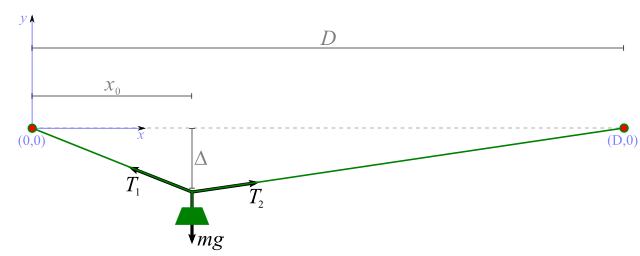Input:
Notes:
-
For all of the length/distance measurements (i.e. all of the fields above
except for the person's weight), you may use any units that you like, as long
as you use the same units for all of them.
-
For the person's weight, you may use lbs, kg, N, kN, or whatever unit of force
you prefer. All of the forces in the output table will be in the same units.
Alternatively, you can leave this field blank (or enter 1) to get results as a
multiple of body-weight.
-
You may omit the value of x0, in which case
a value of D/2 will be assumed. In other words, it
will be assumed that the value of Δ you gave
corresponds to when the person is standing exactly in the middle of the line.
-
If you don't want to consider the effects of a leash fall, you may leave the
last two fields blank, and they will be ignored.
-
Note that D refers to the horizontal distance between
the anchors, not the length of webbing used. Similarly,
x0 refers to the horizontal distance from
the anchor to the person. See the diagram below for clarification on any of
these variables.
|
Output:
| x0 |
Δ |
Static force |
Leash fall force |
g's |
Fall dist. |
Notes:
-
x0 and Δ
represent the same quantities as in the diagram below.
-
The two forces given represent the force on one anchor, namely the anchor from
which x0 (column 1) is measured. Note that
this force is the same as the tension in the portion of the line that is
between the person and that anchor. Since these forces will increase as the
person gets closer to the anchor, the table shows distances that get
progressively closer and closer to the anchor.
-
The “static force” means the force produced from someone just
standing on the line. The values in the “leash fall force” column
are (conjectural) upper and lower bounds on the maximum force
that will be induced if the person falls and is caught by their leash.
-
The “g's” column gives (conjectural) upper and lower bounds for the
maximum acceleration that the person will feel in a leash
fall, as a multiple of gravity (in other words, the maximum “g
force” that they will feel).
-
The “fall distance” column gives (conjectural) upper and lower
bounds for the maximum distance that any part of the person's
body will travel below the level of the anchors during a leash fall.
-
Note that you can easily get the maximum tension that the leash will experience
(which is also equal to the maximum force placed on the ring that attaches the
leash to the slackline) by multiplying the “g force” by the
person's weight.
Color Key:
| Given as input |
|---|
| Assumes nothing but Newton's 2nd Law |
|---|
| Assumes the webbing is “locally linear” with respect to tension |
|---|
| Assumes the webbing is “locally linear” with respect to time |
|---|
| Uses both local linearity assumptions |
|---|
|
The green values should be accurate. The yellow ones are probably somewhat
accurate. The red ones... who knows?
|
|

